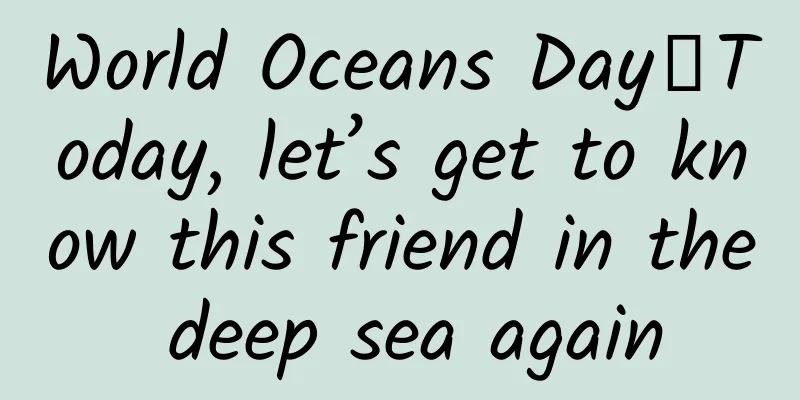World Oceans Day丨Today, let’s get to know this friend in the deep sea again

|
Expert of this article: Liu Yadan, former assistant secretary-general/researcher of China Fisheries Society, national chief scientific communication expert The ocean, one of the most fascinating and mysterious places on earth. There is an "unknown world" hidden there, with smart and cute dolphins, a large number of small fish and shrimps... and many unknown mysterious creatures. Today (June 8) is World Oceans Day. Let us go to the ocean and introduce a precious friend of the deep sea. Copyright image, no permission to reprint It can be said that it is the "excretion champion" among marine organisms, producing the most urine and feces, and has made a huge contribution to the marine toilet. When people mention it, they will unconsciously think of "one thing falls, all things come to life". This animal is a whale. Do you know how much excrement a whale discharges into the ocean? Let's get to know it again through this article. Which marine organisms produce the most excrement? It is the giant in the sea - the whale. How do we calculate the actual amount of excretion of whales? This is a headache for scientists. They can only calculate the daily excretion of smaller and easier-to-observe marine organisms, such as seals and dolphins. Then, based on the size of adult whales, we can further estimate their excretion. The data obtained in this way is not accurate, but it can provide a general concept of the amount of excretion of whales. For example, a 26-meter-long, 72-ton fin whale produces 974 liters of urine a day, which is equivalent to the urine output of an adult in three years. As for how much a whale can excrete in a day, there is no scientific and accurate method to calculate it. But what we know is that whales usually "go to the bathroom" before diving to hunt, excreting a large amount of colorful and smelly feces. Copyright image, no permission to reprint Where does this excrement go? First, we need to understand the food chain in the ocean. At the bottom of the marine food chain are primary producers, who can make their own food by converting the sun's energy into sugars in a process called "photosynthesis." They also provide oxygen to the ocean, further increasing the oxygen concentration in the atmosphere. Phytoplankton, seaweed, kelp and other seaweed are important primary producers and are eaten by marine herbivores, or marine vegetarians. Larger animals such as sea urchins, conchs and mussels, oysters, some fish species, and manatees are herbivores. There are also many marine creatures that are not vegetarians and will eat other marine creatures, including sharks, seals, some seabirds, octopuses, many fish species and mollusks. In addition, there are some omnivores that eat both meat and vegetables, including many whales, turtles, crabs and some seabirds. Whales are at the top of the food chain in the marine ecosystem. They can transfer energy, information, and nutrients, promoting the circulation and development of the entire ecosystem. Copyright image, no permission to reprint Researchers say that whale excrement is gold in the ocean and the most nutritious recyclable resource. Because its feces contain a large amount of undigested nutrients, it can provide delicious bait for plankton and stimulate the growth of phytoplankton, thus providing sufficient food for fish and shrimp in the sea. In other words, whales eat fish and shrimp, but whale excrement feeds plankton, which indirectly feeds fish and shrimp. Whales are like nutrient transport ships in the marine ecosystem. They eat large amounts of nutrients in high-latitude areas where food is abundant, and then transport the nutrients to low-latitude areas where food is less abundant through excretion, a distance of up to thousands of kilometers. They forage for food in the deep sea and swim to the surface to excrete, bringing nutrients from the deep sea to the surface, and also driving the upper and lower nutrient cycles of the ocean. At this point, some people may be curious about a question: What would happen if you were accidentally swallowed by a whale? What would happen if you were swallowed by a whale? When you accidentally fall into the whale's mouth and slip on the whale's tongue, the first thing you face is more than 50 teeth as long as steak knives. After 1 minute, you will enter a sticky area, which is its throat, and you will smell a foul odor. At this point, your struggle will be useless. Copyright image, no permission to reprint As you slide down your digestive tract, the methane gas builds up, and as you reach your intestines, you feel the acid surrounding you corroding your body. Whales have four stomachs, each containing a large amount of gastric juice. After being tossed back and forth by the four stomachs, the body will be thoroughly digested and absorbed and excreted along with the small fish and shrimp. Is it possible to escape? There is a chance. Whales vomit every once in a while, vomiting something that they cannot swallow and makes them feel uncomfortable. If they are lucky, they may be able to escape. But don't be afraid, after all, the probability of being swallowed by a whale is too small. Whales are not very interested in humans, so as long as you don't actively provoke them, you don't have to worry about being attacked. The above assumptions are only to help you understand whales better. Whales are just one of more than 30 million marine species. There are many creatures in the ocean Care for them Protecting the Ocean To protect our common home The cover of this article and the pictures with watermarks in the text are from the copyright library and are not authorized for reproduction |
<<: Beware! Posting photos like this is dangerous! You need to do these two things before sharing
>>: What genes of ancient humans are flowing in us?
Recommend
With the right channels and prices, your product is still not well received?
Nowadays, procrastination has become a social pro...
Scientists have gone to great lengths to find out the "devil" element that killed generations of people
Planning and production Source: Guokr (ID: Guokr4...
Can running a marathon cause sudden cardiac death? Five things to keep in mind when running long distances
The 2023 marathon events are coming, and the ones...
How far can a telescope see? There is no farthest, only farther...
"How far can your telescope see?" This ...
Buttons vs. touch screen: Which is the "optimal solution" for manned spacecraft operating consoles?
In May 2023, the Shenzhou 16 manned spacecraft wa...
Snapdragon 820 version of Samsung S7 latest running score exposed: a new high
As the release is approaching, Samsung S7 is also...
Which platform brings the best returns for posting short videos?
Nowadays, short videos have become a traffic entr...
IDC Server Hosting Service Basic Price
There are two ways to use servers in the IDC fiel...
Why do I feel like there are fewer mosquitoes this year? Is it because of the hot weather? The truth is…
Many people feel that there are fewer mosquitoes ...
iOS Auto Layout Framework – Masonry Detailed Explanation
Currently, most pages in iOS development have beg...
How to use fastboot to flash the original image to Android
If your phone has an unlocked bootloader, you can...
How to take a photo using WeChat on PC? Introduction to the use of WeChat Tap on PC
Can I use WeChat Tap on PC? Everyone is worried a...
A Complete Guide to Business Analysis - Using Data Analysis to Solve Business Problems
A Complete Guide to Business Analysis - Using Dat...
What is the correct enterprise Internet customer acquisition plan?
The following content, a total of 7 steps Knowled...
The cool breeze blows, the cold dew falls
Loading long image... Source: National Geographic...









